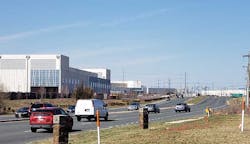Northern Virginia Debates the Future of its Cloud Cluster
This fall, the path for future development in the world’s largest data center market will be decided by decisions on policy and infrastructure in Northern Virginia. Officials in Loudoun and Prince William counties will consider changes in where data centers can be built and what they should look like.
The rapid growth of digital infrastructure has generated community discussion in both counties, and we can expect active discussion about the role of data centers in the suburban landscape. There’s a history of developments in Northern Virginia guiding trends across the data center industry, so these discussions will be closley watched, and are likely to hold lessons for both data center operators and local officials who covet economic development.
Meanwhile, everyone wants the Internet, all the time and with no lag or interruptions. Over the past summer, Data Center Frontier has been closely tracking developments in Northern Virginia. These links offer a primer on the issues the region will be grappling with this fall.
Growth Challenges Prompt Policy Decisions
Loudoun County Prepares New Rules for Where Data Centers Should Be Built: This month the Board of Supervisors in Loudoun County is updating its guidelines for data center development, seeking to address tensions stemming from the enormous growth of the cloud cluster surrounding “Data Center Alley” in Ashburn, Virginia. Loudoun County has more data centers than anyplace on earth, with 26 million square feet of existing space, and another 8 million square feet under development. Cloud builders’ appetite for real estate has left a limited supply of vacant land for development, driving property prices higher, and creating tensions with area residents. Local officials have responded by seeking to update county rules on where data centers should and shouldn’t be developed.
Ashburn Power Crunch May Cause Delays in Data Center Construction: As officials were debating the best ways to manage data center growth, Dominion Energy began telling data center companies that power for some new facilities in Ashburn will be delayed, perhaps for years. The utility cited “transmission constraints in a pocket of eastern Loudoun County that will impact new connections for large customers.” If power delays persist in Eastern Loudoun, future development may shift to nearby markets.
Prince William County Weighs Proposals That Could Accelerate Data Center Growth: Prince William County is the region best positioned to benefit from limits on cloud infrastructure growth in Loudoun County. Prince William could see an acceleration of data center construction, potentially shifting the center of gravity for cloud infrastructure growth. The opportunity is at stake as residents and officials debate how data centers fit in the county’s vision for its future. Compass Datacenters and QTS Data Centers are already seeking permission for massive campuses where they hope to build up to 18 million square feet of space.
Neighbor vs. Neighbor: A Community Debates Data Center Growth: The Prince Williams Digital Gateway project has become the flashpoint for heated debate between groups of residents about the role of data centers in their community. The project was proposed by local landowners seeking to capitalize on rising valuations for data center land, bundling more than 200 properties into a massive 2,100-acre data center park. The Digital Gateway backers are facing opposition from a constellation of groups citing concerns about its impact on the community, the environment and local historic sites.
The Backdrop: The Home of the Cloud
A welcoming business climate and tax incentives have driven rapid growth in the northern Virginia (NoVa) data center market and transformed local real estate. The increased demand has forced what is already the largest data center market in the world to expand outside of Ashburn’s Data Center Alley into the Dulles Cloud Corridor, the Leesburg Cluster, and Prince William County.
Get the full report.
Northern Virginia Data Center Market, featuring Digital Realty, dives into why NoVA is the home of the cloud by exploring 5 key attributes of the market. Notably, the region offers a competitive colocation and cloud environment, a strategic location, it’s relatively free of natural disasters, it has reasonable power costs, and the area has a welcoming business climate. Check out our recent article series focused on the special report:
The Home of the Cloud: Rapid Growth Continues in Northern Virginia: We kick off our article series by first taking a high level look at the current state of the market. This includes data on commissioned and planned data center capacity, market growth, and the attributes that make the NoVa market the home of the cloud.
Why Ashburn is the Hub of Northern Virginia’s Digital Economy: In the second article in our series, we look at the background and history of the NoVa data center market, as well as provide some key market updates. The article explains why Ashburn and Loudoun County are such important sites and how in some cases expansion has meant land owners needed to raze existing buildings in order to construct new data centers.
Bigger Campuses Drive Cloud Growth in Northern Virginia: Next, we look at trends in supply and demand in NoVa. The article notes that “Northern Virginia is the home of the hyperscalers, with the world’s largest concentration of cloud computing infrastructure.” This has lead to the construction of larger data center campuses that have upwards of 100 MW of capacity.
Power and Taxes: The Business Environment in Northern Virginia: We conclude our article series by exploring NoVa business environment, including overviews of power capacity and rates, connectivity, tax incentives and hazard risks.
Download the entire report, Northern Virginia Data Center Market, supported by Digital Realty, to learn more.
Data Center Frontier editor Rich Miller contributed to this article.
About the Author

Kathy Hitchens
Kathy Hitchens has been writing professionally for more than 30 years. She focuses on the renewable energy, electric vehicle, utility, data center, and financial services sectors. Kathy has a BFA from the University of Arizona and a MBA from the University of Denver.


